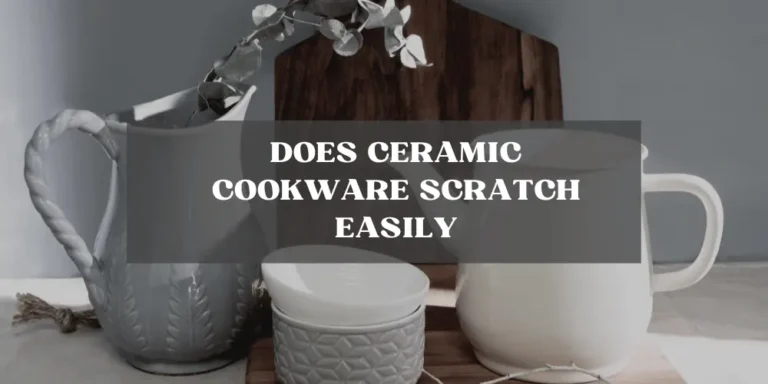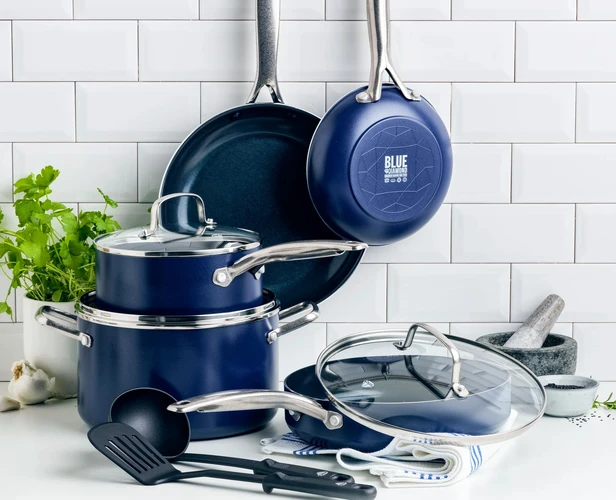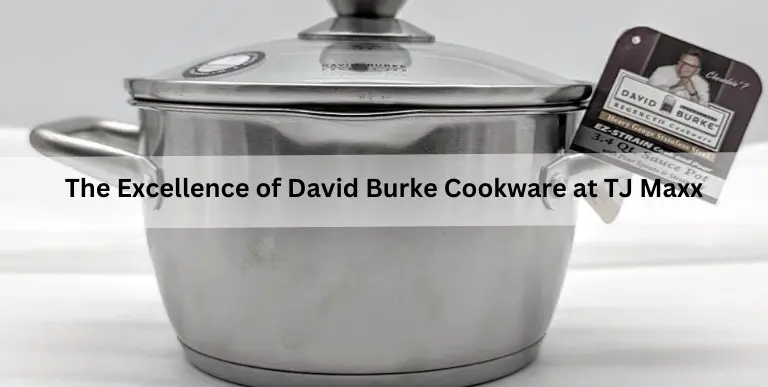Is Granite Cookware Safe? Pros and Cons of Granite Cookware
With growing concerns over the safety of nonstick pans coated in harmful chemicals like PTFE or PFOA, many home cooks are searching for safer, more natural cookware alternatives. Granite cookware has emerged as an intriguing option, but is it truly safe and worth buying?
Granite pans provide a naturally nonstick cooking surface without the worrisome chemicals used in many nonstick coatings. However, granite also has some downsides in terms of weight, care requirements, and potential health risks if low quality.
In this detailed guide, we’ll cover everything you need to know to decide if granite cookware is right for your kitchen, including:
- What exactly is granite cookware and how it’s made
- The pros and cons of granite pans
- Safety concerns over heavy metals and quality control
- Proper use and care instructions
- How granite cookware compares to alternatives like ceramic and stainless steel
- The top granite pan brands on the market
Let’s dive in to unravel the mysteries of this unique stone cookware and see if granite pans deserve a spot in your cabinets!
What Is Granite Cookware?
Granite cookware, sometimes called stone cookware, is made from—you guessed it—granite stone!
Granite pans are constructed by taking thin slices of natural granite and adhering them to the bottom of the pan using a bonding agent. This creates an ultra-smooth, completely nonporous cooking surface. A food-safe sealant is then added to prevent staining and fill any remaining pores.
The result is a dense, durable pan that conducts heat well and provides an inert, nonstick cooking surface right out of the box, with no seasoning required.
Compared to metals like aluminum or copper, granite is less reactive, meaning foods won’t absorb or react with any metallic flavors. Granite also withstands high temperatures better than synthetic nonstick coatings which can degrade over time.
Of course, lugging around a skillet made of solid rock has some distinct disadvantages as well. Keep reading to learn the key pros and cons of granite cookware.
The Pros of Granite Cookware
Naturally Nonstick Surface
The ultra-smooth granite stone offers a nonstick cooking surface without the use of harmful perfluorinated chemicals used in many pans. Foods easily release from properly seasoned granite.
Nontoxic Construction
Pure granite is an inert, natural material that won’t leach chemicals or toxins into foods during cooking. No PFOA, PTFE, or other potentially hazardous compounds.
Extremely Durable
Hard, tough granite holds up well to daily cooking and abrasive scouring without scratching or wearing down over time like low-quality nonstick coatings. Properly cared for, granite cookware can last a lifetime.
Excellent Heat Retention
The dense stone construction provides superb heat retention and distribution for consistent cooking results. Great for searing and browning due to excellent thermal mass.
Stylish Natural Material
The beautiful speckled black, brown, and gray tones of granite make these pans a stylish, natural-looking addition to any kitchen. An eye-catching alternative to boring stainless steel.
Budget-Friendly Price
Granite pans are significantly cheaper than premium ceramic or added nonstick coatings, making them a very wallet-friendly option.
The Cons of Granite Cookware
However, granite cookware isn’t without some downsides to consider:
Very Heavy
Due to the solid granite stone, these pans can weigh significantly more than other cookware, making them difficult to maneuver and unsuitable for people with wrist or arm issues.
Prone to Chipping
Being stone, granite pans are brittle and can crack or chip if dropped or banged around enough. Chips along the rim are common and can lead to uneven cooking.
Not as Nonstick as Advertised
While the granite surface is smooth, it’s not as slick as a well-seasoned cast iron pan or ceramic-coated cookware. Foods may still stick without enough oil or butter.
Can Stain Easily
The natural light granite coloring means tomato sauce, turmeric, and other bold foods can permanently stain the cookware surface.
Special Cleaning Requirements
Granite must be hand-washed gently and re-seasoned after each use. No harsh scrubbing or dishwasher use.
Not for Induction Cooktops
The stone construction makes granite pans incompatible with induction stoves. Only use on gas, electric, ceramic, or glass stovetops.
Now that we’ve weighed the pros against the cons, it’s time to address the million-dollar question:
Is Granite Cookware Safe for Your Health?
Granite cookware seems like it should be safe since it’s made from an all-natural stone material. But is that the case?
When it comes to health and safety, the quality of the granite itself is the most crucial factor.
Pure, high-grade granite that is free of heavy metals like lead, cadmium, and arsenic is completely inert and will not pose any health risks during cooking. Food-grade granite is approved by the FDA for safe contact with food.
However, lower-quality granite may contain small amounts of toxic heavy metals that could potentially leach into foods, especially when cooking acidic ingredients like tomatoes, vinegar, or wine.
The biggest concern is lead contamination, which remains a problem in some imported granite [1]. Excessive lead exposure from contaminated cookware can cause health issues ranging from digestive problems to kidney damage. Children are most vulnerable.
The safest bet is to choose a reputable brand that independently lab tests its granite cookware and provides documentation of passing lead safety tests. American-made granite pans typically have the most rigorous quality control.
With high-grade, lead-free granite, you can feel confident that no harmful chemicals will migrate into your food when cooking at normal temperatures. Proper seasoning will also prevent the raw granite surface from contacting food directly.
Just stick to medium or low heat settings, as extremely high heat may potentially cause trace amounts of metals to leach out over time with repeated use. Gentle cooking is the healthiest for both your pans and your body!
How to Clean and Care for Granite Cookware
Granite pans require a bit more TLC than your average skillet. Here are some tips for cleaning and caring for your granite cookware:
- Hand wash only – Granite is sensitive to sudden temperature changes so can’t be popped in the dishwasher. Use mild dish soap and warm water.
- Avoid abrasives – No rough scouring pads, steel wool, or harsh cleansers that could scratch the surface. Stick to soft sponges and scrubbers.
- Dry thoroughly – Let your granite pan air dry fully to prevent mineral deposits from water spots.
- Re-season after each use – Wipe a thin layer of oil or butter over the cooking surface after cleaning to maintain the nonstick patina.
- Buff out stains – For stubborn stains, use baking soda and water to gently polish away discoloration. Don’t use bleach or other harsh chemicals.
- Store carefully – Place a paper towel lining between stacked granite pans to prevent scratches or chipping.
With the proper care and maintenance, your granite cookware should provide many years of healthy, nonstick cooking.
Is Granite Cookware Worth Buying?
Granite pans offer a safe, all-natural cooking surface free of worrisome toxins found in many nonsticks. But the heavyweight and potential chipping may be a turn-off for some home cooks.
Here are a few things to consider when deciding if granite cookware is right for your kitchen:
Budget-Friendly Stoneware
Granite pans provide an affordable way to get the beauty and cooking benefits of stoneware at a fraction of the cost of premium ceramic cookware.
Durable When High-Quality
Good quality granite holds up exceptionally well with proper use and care. Granite won’t degrade or get scratched up like low-end nonstick coatings.
Not the Most Nonstick
While decent when seasoned, granite won’t provide the ultraslick release of well-made ceramic or diamond-reinforced pans. Some sticking is likely.
Heavy and Prone to Chipping
The dense, brittle stone makes granite pans much heavier than other options. Chips and cracks are an ongoing risk with rough handling.
For cooks wanting natural stone cookware on a budget, who don’t mind some heaviness, and will care for it properly, granite can be an excellent value option that should provide many years of good performance.
Next, let’s look at some top brands making high-quality granite cookware worth considering.
Top Granite Cookware Brands
Here are a few reputable granite pan brands that source durable, high-grade granite to ensure their cookware is free of toxins and safe for daily cooking:
Rock Pan – Rock Pan uses professional-grade granite sourced from quarries in India. Their pans feature stay-cool handles and come in multiple sizes. Rock Pan also offers a “stone care kit” with granite polish and seasoner.
Granite Stone Diamond – This brand uses diamond-reinforced granite for enhanced nonstick properties. Their pans feature a riveted ergonomic handle and tempered glass lid. Granite Stone Diamond pans provide excellent searing due to superior heat conductivity.
Ozeri Stone Earth Pans – Made in Germany with Greblon mineral-based granite, Ozeri Stone Earth pans are free of PFOA, PFAS, APEO, and NMP. Their textured granite surface improves searing and browning.
Granitestone – Based in Florida, Granitestone obtains its natural granite from ethical sources to ensure purity and safety. Their cookware is scratch-resistant and oven-safe up to 550°F.
Klee Cookware – This woman-owned company uses veined black granite for a stylish hammered finish. Klee pans feature stay-cool handles and tempered glass lids. Their 5-layer granite offers excellent nonstick release.
No matter which brand you choose, be sure to reference the pros and cons of granite cookware to ensure you select an option tailored to your cooking needs and style.
Granite Cookware vs. Ceramic vs. Stainless Steel
How does granite cookware compare to other popular options like ceramic and stainless steel? Let’s look at a quick rundown of the pros and cons:
Granite
Pros: Naturally nonstick, no coating to scratch off, excellent heat retention, inexpensive Cons: Heavy, prone to chipping, high maintenance
Ceramic
Pros: Very nonstick when seasoned, durable coating, lightweight Cons: Coating can scratch/degrade over time, more expensive
Stainless Steel
Pros: Heats evenly, sturdy and durable, dishwasher safe Cons: Not nonstick, can react with acidic foods
While ceramic reigns supreme in nonstick ability, granite holds its own as an all-natural, budget-friendly option that excels in searing and browning. For those wanting stoneware on a budget, granite is a great choice.
Granite Pan FAQs
Let’s wrap up by answering some frequently asked questions about granite cookware:
Are granite pans oven-safe?
Yes, most granite pans are oven-safe up to 450-550°F. Always check manufacturer guidelines.
Can granite pans go in the dishwasher?
No, hand washing is strongly recommended to prevent damage from sudden temperature changes and harsh detergents.
Do granite pans work on induction cooktops?
Unfortunately, granite pans are not compatible with induction ranges due to the stone composition. They will only work on conventional gas or electric stoves.
How do you season a granite pan?
Rub a thin layer of oil or butter over the entire interior cooking surface and let it bake for an hour in a 350°F oven. Repeat 2-3 times until nicely seasoned.
Conclusion
While not without some quirks, high-quality granite cookware provides a safe, all-natural nonstick cooking surface free of worrisome toxins found in many pans. With proper care and maintenance, granite pans can be a smart, budget-friendly addition to your kitchen cookware collection. Just be sure to select a reputable brand that independently verifies the purity and quality of the granite used.



